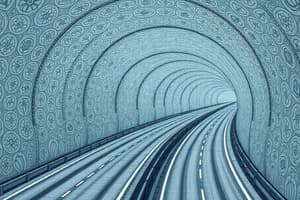Podcast
Questions and Answers
Which of the following milestones in tunnel engineering occurred first?
Which of the following milestones in tunnel engineering occurred first?
- First subway tunnel
- First trans-alpine tunnel
- First railway tunnel (correct)
- First underground railway
The development of electric tunnel boring machines (TBMs) took place in the 1950s.
The development of electric tunnel boring machines (TBMs) took place in the 1950s.
False (B)
Name one key aspect of tunnel engineering.
Name one key aspect of tunnel engineering.
Geology and Site Investigation
The first undersea tunnel precursor was developed in the ______.
The first undersea tunnel precursor was developed in the ______.
Match the tunneling technique with its description:
Match the tunneling technique with its description:
Which method is known for using explosives to break up rock?
Which method is known for using explosives to break up rock?
Regular inspections are unnecessary for maintaining tunnel integrity.
Regular inspections are unnecessary for maintaining tunnel integrity.
What is shotcrete used for in tunnel engineering?
What is shotcrete used for in tunnel engineering?
The primary use of __________ in tunnels is for supports and reinforcement.
The primary use of __________ in tunnels is for supports and reinforcement.
Match the tunnel construction methods with their descriptions:
Match the tunnel construction methods with their descriptions:
Flashcards
Industrial Era Tunnel Engineering
Industrial Era Tunnel Engineering
Tunnel engineering advancements during 1700-1900, driven by steam power and explosives for larger-scale projects, mainly for transportation (railroads & highways) & utilities.
Modern Era Tunnel Engineering
Modern Era Tunnel Engineering
Advancement in materials, machinery, and technology (post-1900), resulting in longer, deeper, and more intricate tunnels using innovative techniques like cut-and-cover, bored tunnels, and immersed tubes.
Mont Cenis Tunnel
Mont Cenis Tunnel
The first trans-alpine tunnel built in 1870
Geology & Site Investigation
Geology & Site Investigation
Signup and view all the flashcards
Tunnel Design
Tunnel Design
Signup and view all the flashcards
Tunnel Lining Material
Tunnel Lining Material
Signup and view all the flashcards
Concrete Lining Advantages
Concrete Lining Advantages
Signup and view all the flashcards
Steel Lining Advantages
Steel Lining Advantages
Signup and view all the flashcards
Shotcrete Lining Advantages
Shotcrete Lining Advantages
Signup and view all the flashcards
Drilling and Blasting (D&B)
Drilling and Blasting (D&B)
Signup and view all the flashcards
Study Notes
Construction Principles CSP115B (Week 7 – Tunnels)
- Tunnel engineering is a specialized field of civil engineering focused on the design, construction and maintenance of tunnels.
- Tunnels are underground structures for transportation, utilities, or other purposes.
- Tunnels can be built using various methods and materials, depending on geological conditions, tunnel length and intended use.
Introduction to Tunnel Engineering
- Tunnel engineering deals with the design, construction, and maintenance of tunnels.
- Tunnels are underground structures that facilitate transportation, utilities, or other functions.
- Tunnel construction methods vary based on geological conditions, size, and intended use.
Danville Tunnel
- Images of the Danville tunnel.
Introduction to Tunnel Engineering - History
- Tunnel construction has ancient origins, used for irrigation, transportation, and military purposes.
- Ancient civilizations like those in Egypt, Greece, and Rome, developed sophisticated tunnel systems.
- Evidence of tunnels for those purposes exists.
History of Tunnel Engineering - Ancient Era
- Egyptians constructed tunnels for tombs and temples (e.g., the Great Pyramid of Giza).
- Greeks and Romans built tunnels for aqueducts, sewers, and military purposes.
- The beginning of construction dates back thousands of years.
History of Tunnel Engineering - Medieval Era
- Tunnel construction declined in Europe during this period.
- Some tunnels were constructed for castles and monasteries.
History of Tunnel Engineering - Renaissance Era
- Tunnel engineering was revived with the construction of canals and mines.
- This period saw a resurgence in interest and construction of tunnel structures.
History of Tunnel Engineering - Industrial Era
- The development of steam-powered machinery and explosives permitted larger-scale tunnel projects.
- The construction of railroads, highways, and utilities stimulated innovation in tunnel engineering.
- Technological advancements improved construction methods.
History of Tunnel Engineering - Modern Era
- Advancements in materials, machinery, and technology allowed for longer, deeper, and more complex tunnels.
- Improved techniques such as cut-and-cover, bored tunnels, and immersed tubes were developed.
- The modern era has many advancements and techniques making construction faster and more sophisticated.
History of Tunnel Engineering - Notable Milestones
- 1825: First railway tunnel (Liverpool and Manchester Railway)
- 1863: First underground railway (London Underground)
- 1870: First trans-alpine tunnel (Mont Cenis Tunnel)
- 1880: First subway tunnel (New York City Subway)
- 1900s: Development of electric tunnel boring machines (TBMs)
- 1950s: First undersea tunnel (Channel Tunnel precursor)
- 1980s: Development of modern TBMs and advanced tunneling techniques.
History of Tunnel Engineering
- Tunnel engineering continuously evolves due to advances in technology, materials, and societal requirements.
- The development of newer, more elaborate tunnels continues to this day.
Key Aspects of Tunnel Engineering - Geology and Site Investigation
- Understanding geological conditions (soil types, groundwater levels, and potential hazards like fault lines).
- Conducting site investigations (boreholes, geophysical surveys).
- The purpose of gathering geological data to enable safe and effective construction decisions.
Key Aspects of Tunnel Engineering - Tunnel Design
- Determining tunnel shape, size, and alignment based on geological and other factors (hydrology).
- Choosing suitable linings like concrete, steel, or shotcrete to ensure structural integrity.
- Tunnel alignment plays an important role in factors like cost and safety.
Key Aspects of Tunnel Engineering - Construction Methods
- Drilling and Blasting (D&B): Using explosives to break up rock.
- Tunnel Boring Machines (TBMs): Mechanical excavation using rotating cutting wheels.
- Cut-and-Cover: Excavating from the surface and covering the structure.
- Immersed Tubes: Constructing pre-fabricated tunnel sections and sinking them into place.
Key Aspects of Tunnel Engineering - Materials and Linings
- Concrete (cast-in-place or precast segments).
- Steel (for linings, supports, and reinforcement).
- Shotcrete (sprayed concrete).
Key Aspects of Tunnel Engineering - Maintenance and Rehabilitation
- Regular inspections for potential problems.
- Maintenance tasks (cleaning, repairs).
- Upgrading the tunnels for lifespan extensions.
- Tunnels require regular checks and upkeep to ensure structural integrity.
Tunnel Engineering Methods - Drilling and Blasting
- Using explosives to break up rock, removing debris by mechanical means.
- Hard rock suitability, slow process with vibrations.
Tunnel Engineering Methods - Tunnel Boring Machines (TBMs)
- Mechanical excavation using rotating cutting wheels.
- Fast and efficient but high capital costs with limited flexibility.
- Types: Earth Pressure Balance (EPB), Slurry Shield, Open-Face.
Tunnel Engineering Methods - Cut-and-Cover
- Excavating from the surface, then covering with a lid.
- Suitable for shallow tunnels, susceptible to surface disruptions.
Tunnel Engineering Methods - Immersed Tubes
- Constructing pre-fabricated sections, sinking them into place.
- Ideal for underwater tunnels or minimal surface disruption situations.
Tunnel Engineering Methods - Hand Mining
- Labour-intensive method using hand tools and small machinery.
- Suitable for small-scale tunnels or areas with limited access.
Tunnel Engineering Methods - Mechanized Cut-and-Cover
- Combines mechanical excavation with cut-and-cover techniques.
- Faster than traditional cut-and-cover with a high surface impact rate.
Tunnel Engineering Methods - Pilot Tube Microtunneling
- Uses a small, remotely controlled machine to bore a pilot tunnel, typically in a controlled atmosphere.
- Small tunnel alignment improvement.
Tunnel Engineering Methods - Pipe Jacking
- Pushing pre-fabricated pipes through the soil using hydraulic rams.
- Suitable for smaller-diameter tunnels, like utility pipes.
- Can be used as a means to construct tunnels underground in certain circumstances.
Tunnel Engineering Methods - Box Jacking
- Similar to pipe jacking, but wider, box-shaped sections are used.
- Suitable for larger tunnels, like subway stations.
- Box jacking can be more efficient over large distances and areas needing significant coverage, but in turn there are limitations due to the size of the tunnel structures created.
Factors Considered in the Design of Tunnels - Geology.
- Rock type and strength
- Soil composition and density
- Groundwater levels
- Fault lines and seismic activity
Factors Considered in the Design of Tunnels - Tunnel Purpose and Use
- Transportation (highway, railway, pedestrian)
- Utilities (water, sewage, gas, electricity)
- Mining or excavation
- Military purposes
Factors Considered in the Design of Tunnels - Tunnel Alignment and Profile
- Horizontal and vertical curves
- Gradient and slope
- Tunnel length and depth
Factors Considered in the Design of Tunnels - Tunnel Size and Shape
- Diameter or width
- Height or clearance
- Cross-sectional shape (circular, rectangular, etc.)
Factors Considered in the Design of Tunnels - Materials and Linings
- Concrete
- Steel
- Shotcrete
- Waterproofing
Factors Considered in the Design of Tunnels - Hydrology and Water Management
- Groundwater control and drainage
- Surface water runoff and management
- Flood protection and emergency response
Factors Considered in the Design of Tunnels - Ventilation and Air Quality
- Fresh air supply and exhaust systems
- Air quality monitoring and control
- Emergency ventilation and evacuation plans
Factors Considered in the Design of Tunnels - Lighting and Electrical Systems
- Lighting design and installation
- Power supply and distribution
- Communication and signaling systems
Factors Considered in the Design of Tunnels - Safety and Emergency Response
- Fire protection and suppression systems
- Emergency response plans
- Safety signage and communication systems
Factors Considered in the Design of Tunnels - Constructability and Logistics
- Construction methods and sequencing
- Site access and logistics
- Material transportation and storage
Factors Considered in the Design of Tunnels - Cost and Budget
- Initial construction costs
- Long-term maintenance costs
- Operation costs
- A full life-cycle cost analysis
Support Systems and Linings used in Tunnel Engineering - Support Systems
- Rock bolts
- Steel ribs
- Shotcrete
- Steel mesh
- Timber supports
Support Systems and Linings used in Tunnel Engineering - Linings
- Cast-in-place concrete
- Precast concrete segments
- Steel linings
- Composite linings
- Membrane linings
Support Systems and Linings used in Tunnel Engineering - Additional Systems
- Grouting
- Anchors
- Nailing
- Mesh drapes
- Sprayed concrete arches
Some Examples of Tunnels - Channel Tunnel
- Year: 1994
- Length: 50 km (31 miles)
- Diameter: 7.6 m (25 ft)
- Depth: Up to 40 m (131 ft)
- Type: Undersea tunnel
- Country: England - France
Some Examples of Tunnels - Gotthard Base Tunnel
- Year: 2016
- Length: 57 km (35.4 miles)
- Diameter: 8.8 m (29 ft)
- Depth: Up to 2,300 m (7,500 ft)
- Type: Railway
- Country: Switzerland
Some Examples of Tunnels - Seikan Tunnel
- Year: 1988
- Length: 53.8 km (33.5 miles)
- Diameter: 9.1 m (30 ft)
- Depth: Up to 240 m (787 ft)
- Type: Undersea tunnel
- Country: Japan
Some Examples of Tunnels - Big Dig Tunnel
- Year: 2007
- Length: 5.6 km (3.5 miles)
- Diameter: 8.5 m (28 ft)
- Depth: Up to 30 m (100 ft)
- Type: Highway
- Country: Boston, USA
Some Examples of Tunnels - London Underground Tunnels
- Year: Various (1863-2020)
- Length: Up to 12 km (7.5 miles)
- Diameter: 3.5-4.2 m (11.5-13.8 ft)
- Depth: Up to 30 m (100 ft)
- Type: Subway
- Country: London, England
Some Examples of Tunnels - Gibraltar Tunnel
- Year: 1967
- Length: 1.8 km (1.1 miles)
- Diameter: 6.5 m (21.3 ft)
- Depth: Up to 30 m (100 ft)
- Type: Road tunnel
- Country: Spain
Some Examples of Tunnels - Mont Blanc Tunnel
- Year: 1965
- Length: 11.6 km (7.2 miles)
- Diameter: 8.6 m (28.2 ft)
- Depth: Up to 2,000 m (6,562 ft)
- Type: Road
- Country: Italy
Studying That Suits You
Use AI to generate personalized quizzes and flashcards to suit your learning preferences.




